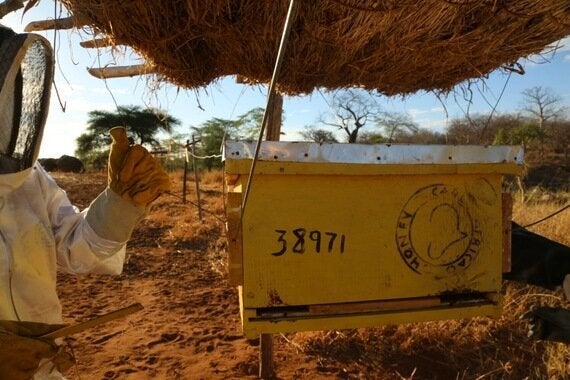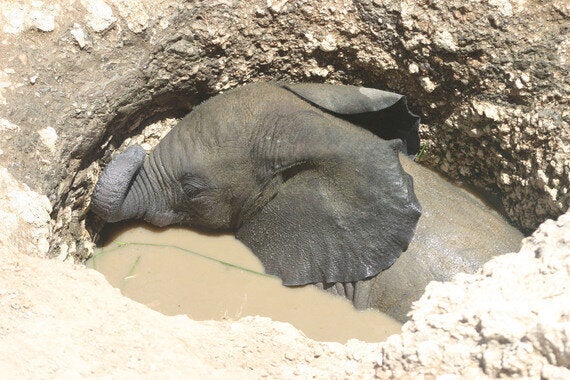Quite possibly, the answer is: You don't.
Across the world, species of wildlife are fast disappearing, silently becoming extinct. Thankfully, charismatic elephants seem to hold a special place in many people's hearts and, for that, I'm thrilled.
We've worked hard to raise awareness of the plights facing elephants; of ivory poaching that, at its height, was killing 96 elephants a day. There's no saying this slaughter has been stopped in its tracks completely but, in many places, it's been hugely reduced. For instance, in Tsavo National Park where we work, home to Kenya's largest elephant herds, ivory poaching fell 50% between 2012 and 2015 thanks to dedicated and coordinated efforts by our DSWT/KWS Anti-Poaching Teams, Aerial Surveillance Unit and the actions of other NGOs.
But we can't save elephants in the long-term if they have no home in which to live and roam, and this is a frightening prospect facing many populations. In Kenya, the loss of biodiversity and habitats is causing habitat fragmentation and disruption to traditional migratory routes, increasingly bringing wildlife into conflict with humans and communities. There is a very real prospect that for every elephant life saved from the clutches of ivory poachers, they could then be hit by a speeding car, killed in a revenge attack by communities for eating their crops or have their young fall down drainage holes or wells.
But there are local, effective, cost efficient and sustainable solutions out there that can put a stop to these killings, reduce human-wildlife conflict and, ultimately, pave the way for securing the long-term future of elephants. Here are our top three:
1. Erecting Bee Hive fences:

Beehive fences provide a non-aggressive way of curbing human-wildlife conflict caused by crop raiding, an issue facing many communities on the borders of national parks as farms are built on buffer zones or migratory routes used by elephants. Farmers can lose crops, property and even lives - WWF estimate that some 500 people are killed each year by elephants - and, frequently, wild animals including elephants are killed in retaliation.
But by simply erecting beehives along a fence line, we can harness elephants' little known natural aversion to bees and reduce incidences of crop raiding. This is what we've done in some of Tsavo's communities hardest hit by elephant invasion, erecting more than 2.2km of fence lines with modern beehives. So averse are elephants to bees that not all the hives need to be inhabited. In fact, dummy hives are utilised to keep costs manageable and evidence from Dr. Lucy King, the pioneer of beehive fences, shows an 80% success rate in stopping elephants by using these fences. But it doesn't just save elephants' lives and farmers' crops. Crops are being better pollinated as the bee population increases, whilst communities also benefit financially from sales of honey.
2. Consider wildlife's needs when building infrastructure:

Elephants can live alongside humans if their needs are considered during the development of infrastructure and communities, and measures are incorporated for wildlife. In Northern Kenya, an underpass beneath a busy road allows herds to safely pass without being hit by trucks and cars. On a smaller scale, building permanent boreholes that provide a constant source of water can dissuade elephants from wandering beyond safe boundaries and into newly built communities for water in the dry season. At the DSWT, we've built 11 wind powered boreholes, all of which are serviced and maintained, across the Greater Tsavo Conservation Area in strategic locations. As well as keeping thirsty elephants hydrated, they're built with wildlife in mind: Shallow and wide, so no young calves get stuck - an issue that's common when ad hoc community wells are built with no side reinforcements.
3. Community Conservation Initiatives to ensure the wilderness remains wild:

In Kenya, forest cover amounts to just 6.9% of the country yet in these last remaining strongholds, illegal logging and charcoal burning loom large. Community-led initiatives have proven successful in countering these threats and even in reversing their impact: Working in partnership with the Lamu Conservation Trust, since we've leased Amu Ranch, and embarked on replanting, anti-poaching patrols and removing illegal livestock grazers, Lamu's lost elephant herds have returned. Elephants that had not be seen for years have been captured on remote sensor-triggered camera traps, even with young, which is great news for the 40 strong herd that are the only known elephants left in the area.
But securing habitats for elephants can be sustainable in itself. Elephants aren't known as the gardeners of Africa for nothing. Expert gardeners, they disperse seeds through their dung, clear paths through thick bush enabling smaller animals access to grasslands and even their footprints, which hold water after rains, directly support life. In short, they sustain the forests as much as the forests sustain them.
These are just three of the activities we are undertaking in Kenya to help people and elephants not only live together, but better understand each other. We have a responsibility - morally, financially and ecologically - to protect nature and the life it supports, we have to do this in a way that is mindful of constant human expansion and that is entirely possible. For us at the DSWT, working on the ground, we instantly witness the benefits of these activities and we know that they will help ensure that elephants have a future in Kenya.
Learn what's it's like to be an elephant growing up in the world today by tuning into Elephant Family and Me on Boxing Day, BBC Two at 8.30pm and 27th December, BBC Two at 8pm.
Support the work of the David Sheldrick Wildlife Trust at: www.sheldrickwildlifetrust.org